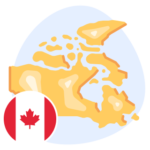For international students who want to study in Canada, the province of Ontario offers tons of options. Do you choose a large city with lots of services and vibrant culture, but a high cost of living?
Maybe you want to be in a lively university town (much like ApplyBoard’s home base in Waterloo Region, where post-secondary students are over 12% of the community’s population)?
Or, perhaps you’re looking for somewhere a bit less hectic and more close-knit, where classes are more interactive because the student-to-faculty ratio is smaller, and the institutions you attend have enviably high employment rates?
There are advantages and drawbacks to each choice. Below, we look closer at why studying in rural or northern Ontario could be right for you!
Wondering how to choose where to study in Canada? Read our blog for some ideas.

More Affordable Cost of Living
Over the past few years, the cost of living in many popular study abroad countries has increased alongside inflation. This impacts everyone, including international students.
So, it’s worth considering more rural and northern communities in Ontario when you decide where you’re applying. Because of Ontario’s higher population density, many smaller communities enjoy a lower cost of living (cheaper rent and utilities, and often more affordable tuition). But because of that density, you’ll still be close enough to travel to cities like Toronto, Ottawa, Hamilton, or Windsor for a weekend.
As with any smaller community, while there may be less competition for housing, there may also be fewer options overall. So, plan out where you’re going to live as early as possible. If you can, it’s smart to get someone you trust who’s already in Ontario to check any off-campus place you’re serious about renting before you sign the lease, too.
Tip: Some institutions offer guaranteed on-campus housing for first year students. Check for this option when you look into different institutions. If your housing is built-in, planning your study abroad journey gets a little easier!
Looking for ways to boost your budget? Check out our scholarships guide for international students in Ontario.

Post-Graduation Employment Opportunities
For international students in northern and rural Ontario, graduation means that they may be able to access employment opportunities which their peers in larger cities can’t. International students who study at Canadian Designated Learning Institutions (DLIs) may be eligible for the federal Post Graduation Work Permit Program, but students who graduate from rural and northern-area DLIs who want to work after graduation in the community they studied in can take their PGWP one step further.
How does it work? Grads from select Ontario communities are eligible for Canada’s Rural and Northern Immigration Pilot (RNIP). This pilot program is currently slated to run until July 2024, but it may be extended. The RNIP encourages newcomers to pursue permanent residency in smaller Canadian communities. Currently, there are 11 participating communities, 5 of which are in Ontario.
Ontario cities participating in RNIP are:
- North Bay
- Sault Ste. Marie
- Sudbury
- Thunder Bay
- Timmins
To be eligible, students must meet general RNIP language, education, and financial independence requirements, and also meet specific requirements set by the individual RNIP community.
Note: A key RNIP requirement is that you must have lived in an eligible community for at least 16 of the last 24 months at the undergraduate level, or the last two years at the graduate level. This is important to remember when planning your studies!
Future-Facing Programs
Rural and northern Ontario colleges offer programs with the best of both worlds. You’ll have classroom time with dedicated instructors, as well as hands-on fieldwork or co-op learning. Wondering which college could be your perfect match? Read on to learn about some of our most popular partner institutions and the programs they’re known for.
Cambrian College
Cambrian College‘s main campus is located in Sudbury, the largest city in northern Ontario. This means graduates may apply for a RNIP work permit, an advantage over new grads from elsewhere in Ontario.
Cambrian is well-known for its heavy equipment technician diploma. As noted in the college’s Maclean’s profile: “Cambrian has received national recognition for its programs in skilled trades and information technology: the school is a certified Cisco Networking Academy and … students have won more than 70 medals at both the Skills Ontario and Skills Canada competitions.” Its mining engineering technology advanced diploma is also highly respected, and the only one of its kind in Ontario.
Canadore College
If you’re interested in media studies or health science programs, consider Canadore College. Canadore also offers programs in aviation studies, business, Indigenous studies, skilled trades, and biotechnology and environmental studies. Students can choose from four campuses in North Bay (an RNIP community) and Parry Sound. More business-inclined students can hone their skills at three affiliated Stanford International College of Business and Technology locations.
Plus, you’ll be joining grads with impressive track records. New Canadore graduates had an 89% employment rate and 100% employer satisfaction rate within 6 months of graduation (2020–21 graduating classes).
Confederation College
Students at Confederation College have one of the highest graduation employment rates in the province, at 91.1%. They’ll learn practical, future-facing skills in fields from computer programming to early childhood education. The main campus is in the growing, outdoorsy city of Thunder Bay (which also means if you study on the main campus, and want to gain Canadian work experience after finishing your studies, you may be eligible for RNIP).
One of Confederation’s signature programs is in aerospace manufacturing engineering technology, where students learn how to construct and upgrade airplanes. Popular graduate programs include health informatics or health administration and leadership. Plus, both of these graduate programs will prepare international students for leadership roles in Canada’s growing health sciences sector.
Fleming College
International students can pursue one of over 75 programs at Fleming College. Fleming has four campuses in Haliburton, Lindsay, Peterborough, and Toronto, and its science programs are among its most renowned, including environmental and natural resource studies. Additionally, Fleming offers unique programs in business, social services, and museum management and curatorship. Fleming graduates are more likely to be employed than the average Ontario college graduate, with an 87% employment rate compared to the province’s 83.3%.

We hope learning about studying in rural or northern Ontario has helped you define your study abroad goals. Next, check out these colleges’ program pages to learn more!
These are only a handful of the institutions in these regions. Want to look closer? Use the free ApplyBoard quick search function to find study abroad programs that match your background and budget.




